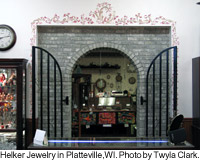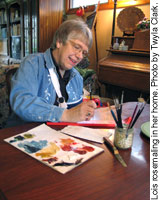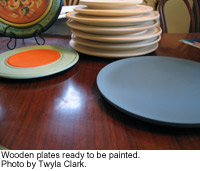|
Home | Search | The Artists | Teaching | Hiring | About This Site | Contact Us |
|||||

Norwegian Rosemaling
Traditional arts are rich with meanings. Some traditional arts have meanings connected to a community or a family. For Lois, rosemaling connects with both! From Norway to Wisconsin Rosemaling began in Norway but spread to the United States during the great Norwegian migrations of the 1840s and 1910s. Since then, the art has had two revivals. A revival is when people become interested again in something that was nearly forgotten or was taken for granted.
Per’s fame and commercial success sparked a huge interest in rosemaling among the people of southern Wisconsin, many of whom had Norwegian ancestry. Many people stopped by Per’s studio to watch him paint. Many of those people went on to be great rosemalers too.
The second revival came in the late 1960s thanks to the Vesterheim Norwegian-American Museum in Decorah, Iowa. The museum offers many classes and exhibits in rosemaling and other traditional Norwegian arts. It has large collections of Norwegian and Norwegian-American folk art. It sponsors a national competition each July in traditional Norwegian rosemaling, woodcarving, weaving, and knifemaking. Through these activities, Vesterheim has helped to build enthusiasm for rosemaling in the Upper Midwest and beyond. Rosemaling in Wisconsin
Do you have to be Norwegian-American to have rosemaling as a cultural symbol? No! If you live in a town that uses rosemaling to represent its cultural identity, then rosemaling is part of your
identity too. That’s how Lois became involved in
A family affair
Husband Ron Mueller makes much of the unfinished woodenware and etched glass on which Lois paints. Son Chris Mueller and his wife Vicki make woodenware for other rosemalers to paint on. They make bowls, plates, mangle boards, and round trunks. These wooden plates are examples of their work.
This display will show you some of the woodenware that Lois has painted. Tines are bentwood boxes that come with lids held down by wooden clamps. “I like to think it was their answer to Tupperware,” she says. A favorite piece of furniture to rosemal is the three-legged chair with a bentwood back. Why only three legs? Lois offers a theory: “My husband said, ‘Three legs, it doesn’t rock. If you have a fourth one and your floor is uneven, it rocks.’” Lois Mueller connects with rosemaling through family and community traditions. Others in Wisconsin connect through their Norwegian ancestry. Are there any rosemalers in your community? Find out what their connections to the tradition are. In Your Community There are lots of rosemalers in Wisconsin! Check with a local Sons of Norway lodge or with one of the many rosemaling associations in the state. Resources for Students has a link to these and other ways to connect with a rosemaler in your own community! |

For Educators: |
||||
|
|
|||||
|
Home | Search | The Artists | Teaching | Hiring | About This Site | Contact Us |
|||||

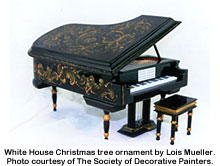 What kind of tradition?
What kind of tradition?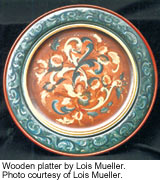 The first
rosemaling revival was in the 1930s in Stoughton, Wisconsin thanks to Norwegian
The first
rosemaling revival was in the 1930s in Stoughton, Wisconsin thanks to Norwegian 